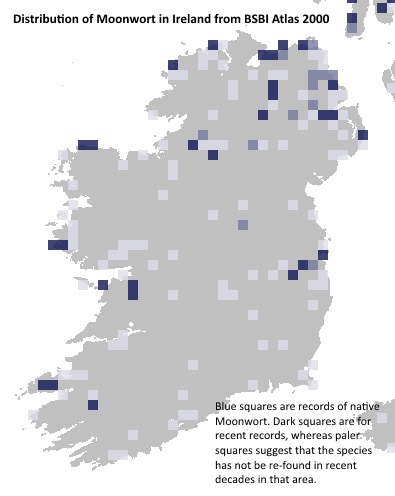Status
Native status
Native species
Species Biology
Identification
- Sporophyte plants grow to 5-28 cm, and produce spores from June to August on the fertile spike.
- The small green plants may be hard to spot in longer grass.
- Unlike other ferns the fronds (leaves) do not uncoil spirally. The frond is made up of two parts.
- The shorted larger leaf blade is non-fertile and is pinnately divided into fan-like sections, of which there are 4-10 pairs.
- The longer fertile spike is narrow and taller and is irregularly branched. It
emerges from the non-fertile frond and is covered in spores in late summer.
Similar/related species:
There are only three species of ferns in
the Ophioglossaceae family which occur in Ireland. Moonwort differs from the other
two species (Adder’s tongue ferns) in that it has a pinnately dissected frond.
Adder’s tongue fronds are entire and simple.
Habitat
Moonwort is a small fern which grows in well drained short grassy habitats on base-rich soils, open sunny places, heaths and dunes. Moonwort is widespread throughout Ireland but only in low numbers. It can be difficult to find, even at known sites.
Both the perennial root of the sporophyte
frond and the tiny gametophyte generation which lives deep in the soil
associate with fungi species to survive. Plants die down at the end of summer
and may not reappear for several years.
Threats faced
Moonwort habitats are under threat of being lost due to land abandonment, changes of use, and agricultural improvement.
Distribution
World distribution(GBIF)
BSBI distribution map

Temporal change
Records submitted to Data Centre in 2025
The following map is interactive. If you would prefer to view it full screen then click here.
How can you help
If you have seen Moonwort or any
of the species in the Irish Species Project, please fill out a recording form.
It can be downloaded here, and you
can also download the guidance document
for detailed instructions (both also available at http://www.bsbi.org.uk/ireland.html).
You can also get in touch with your local
BSBI Vice County Recorder via Maria Long, BSBI Irish Officer (maria.long@bsbi.org) or contact her if you have any questions.
Further information
One of eight species chosen for the Irish Species Project, a two year recording effort by the Irish division of the Botanical Society of Britain and Ireland (BSBI). All eight species are thought to be declining, at least in parts of their range.
Full list of eight species included in the Irish Species Project:
Moonwort (Botrychium lunaria), Cyperus Sedge (Carex pseudocyperus), Autumn Gentian (Gentianella amarella), Toothwort (Lathraea squamaria), Grass-of-Parnassus (Parnassia palustris), Cowslip (Primula veris), Common Wintergreen (Pyrola minor), Cranberry (Vaccinium oxycoccos)
References
Publications
Jermy C. and Camus J. (1991). The illustrated field guide to ferns and
allied plants of the British Isles. London: Natural History Museum Publications
Merryweather J. and Hill M. (1995). The fern guide: an introductory guide to the
ferns, clubmosses, quillworts and horsetails of the British Isles. Shrewsbury:
Field Studies Council (Great Britain) 2nd ed.
Parnell J. and Curtis T. (2012) Webb’s An Irish Flora. Cork: Cork
University Press 8th ed.
Preston C.D., Pearman D.A. and Dines T.D.
(2002) New Atlas of the British and Irish
Flora: An Atlas of the Vascular Plants of Britain, Ireland, the Isle of Man and
the Channel Islands. Oxford: Oxford University Press
Stace C. (2010) New Flora of the British Isles. Cambridge; New York: Cambridge
University Press 2010 3rd ed.
